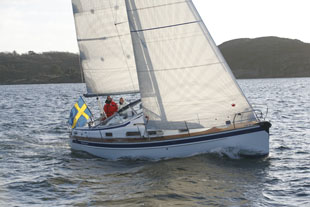The story behind the Hallberg Rassy 310 test

The last time we ran a 24-hour test from Ellös we were sailing the excellent 372, recently voted European Yacht of then Year 2010, in -6°C with a 10-12 knot northeasterly straight from the Arctic watering the eyes. This time it was rather balmy for a Swedish November but we had 20-28 knots from the south. The original plan had been to sail southwest across the Skagerrak to and from Skagen, Denmark, but nobody was relishing a 40-mile beat across open water in a Force 7-8 so we decided instead to head for Smögen, about 15 miles north as the crow flies.
As the wind gusted around the mogul field of smooth, pine-tufted rocks that form this wonderful archipelago, we left Ellös and beam reached west into Ellösefjorden with full jib and a single reef in the main, making 6.2-8.2 knots with 18-28 knots over the beam. We passed north of the fishing town of Gulholmen, out of the fjord’s shelter and into the wild Skagerrak. We bore away north, towards Lysekil, goose-winging gingerly on a dead run making 6.9-8 knots with 18-22 knots of apparent wind over the stern. Looking aft, white horses thundered down our wake after stampeding 200 miles up the Kattegat. Any reservations we had about cancelling the crossing to Skagen disappeared in the spray.

After running up the inside of Stora Kornö we came up onto a broad reach and headed for Malmön, thundering along at 7.2-8.7 knots with 22-27 knots of apparent wind whistling around our ears. Now we were out of the lee of off-lying islands the wind piped up still further and the waves became steeper, rolling under the port quarter. Despite a slight rumble transmitted by the tiller, she felt gloriously responsive, easily controlled, well-weighted and responsive – we’d had very little trouble holding the goosewing earlier. Tiller in hand, she seemed bigger somehow. She punched well above her weight in the conditions and the cockpit felt so secure that it occurred to none of the four very experienced yachtsmen onboard to wear a lifejacket – nobody perceived any need.

By now the 6ft waves were rolling under her broad port quarter and some quick, dramatic tiller adjustments were required to prevent broaching. That worked for a while but it was only a matter of time before we discovered the heel at which the rudder lost its grip. It’s 30°. At one stage we had to bear away onto a dead run to clear a shallow ledge marked with east and west cardinals. Just as we were passing the east cardinal, the helmsman felt the heel build, the rudder stall and she slewed up, heading straight for the mark.
Heading into the wind wasn’t an option as the heel would have draped the mast, sails and rigging over the cardinal with predictable consequences. The only plan was to head straight for the mark, get hydrodynamic flow over the rudder and try to bear away again. We passed the mark to leeward, close enough for the helmsman to warn photographer Graham Snook, currently crawling back from filming on the foredeck, to mind his head as the mark passed by less than a foot to windward. How it missed the shrouds, we’ll never know.

Then Graham noticed that one of the tiller-to-chin corrections we’d made had caused the laminated ash tiller to crack at the tiller head. It was now flexing in a way that was less than reassuring, particularly as we were just a couple of miles off a lee shore. Suitably chastened, we temporarily suspended our test, furled the jib and chose a deep reach of 150° to the apparent wind, by now registering 24-32 knots. Reassured that we were now back in control we enjoyed bowling along at 6.7-10 knots, but with the true wind now clocking in the 40s, we decided to head for the lee of Bohus-Malmön, drop the sails and take the narrow, well-sheltered inside track west towards Smögen under power.

Alongside Smögen’s boardwalk a quick inspection revealed that the tillerhead, a stock stainless steel fitting no longer used in the 310s production, had its three securing bolts in line, right along the laminate, rather than staggered. Magnus made a quick phone-call and within the hour the new design of tiller and head were fitted, this time the head had staggered bolts as well as the HR logo stamped into it.




